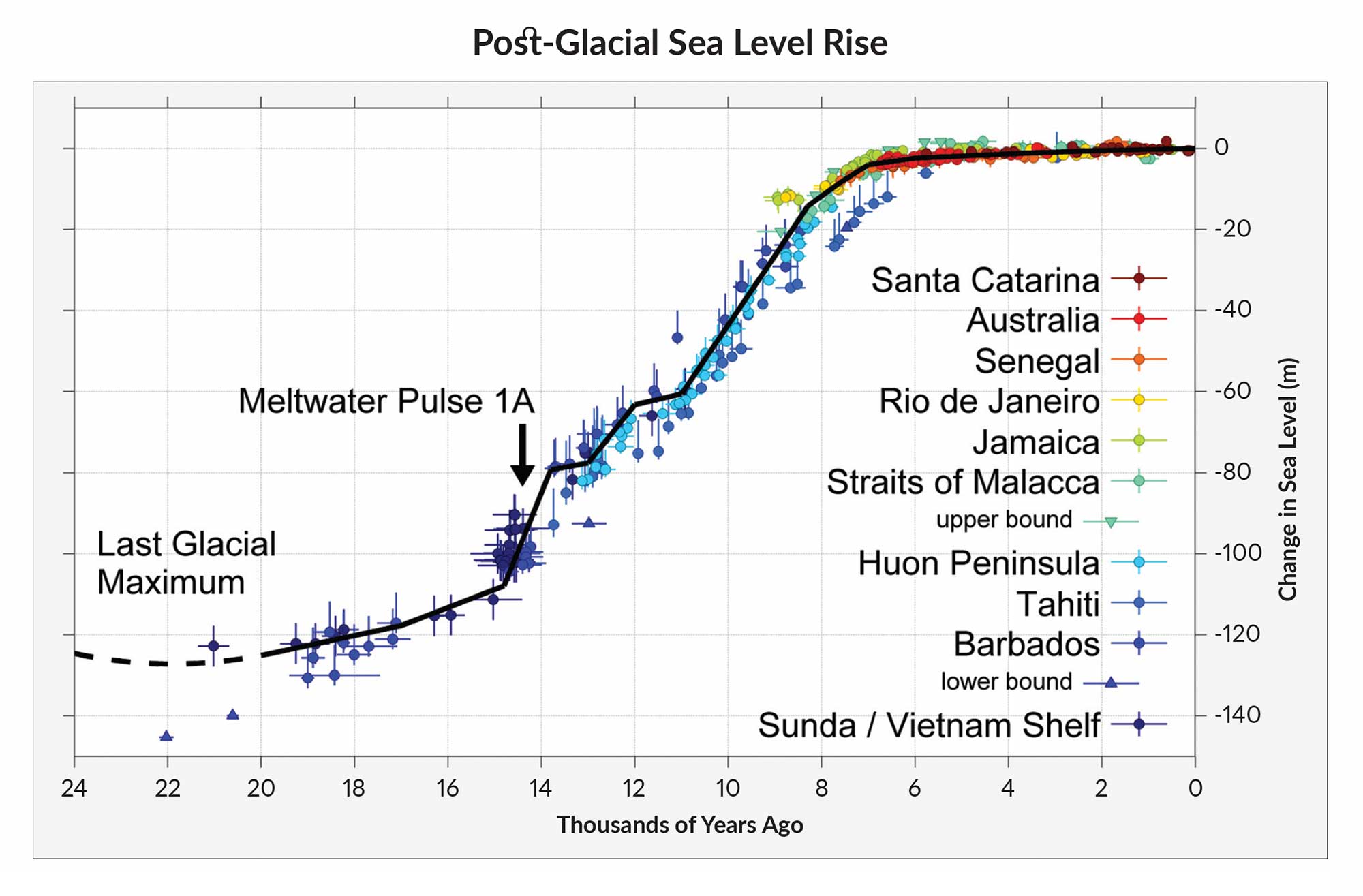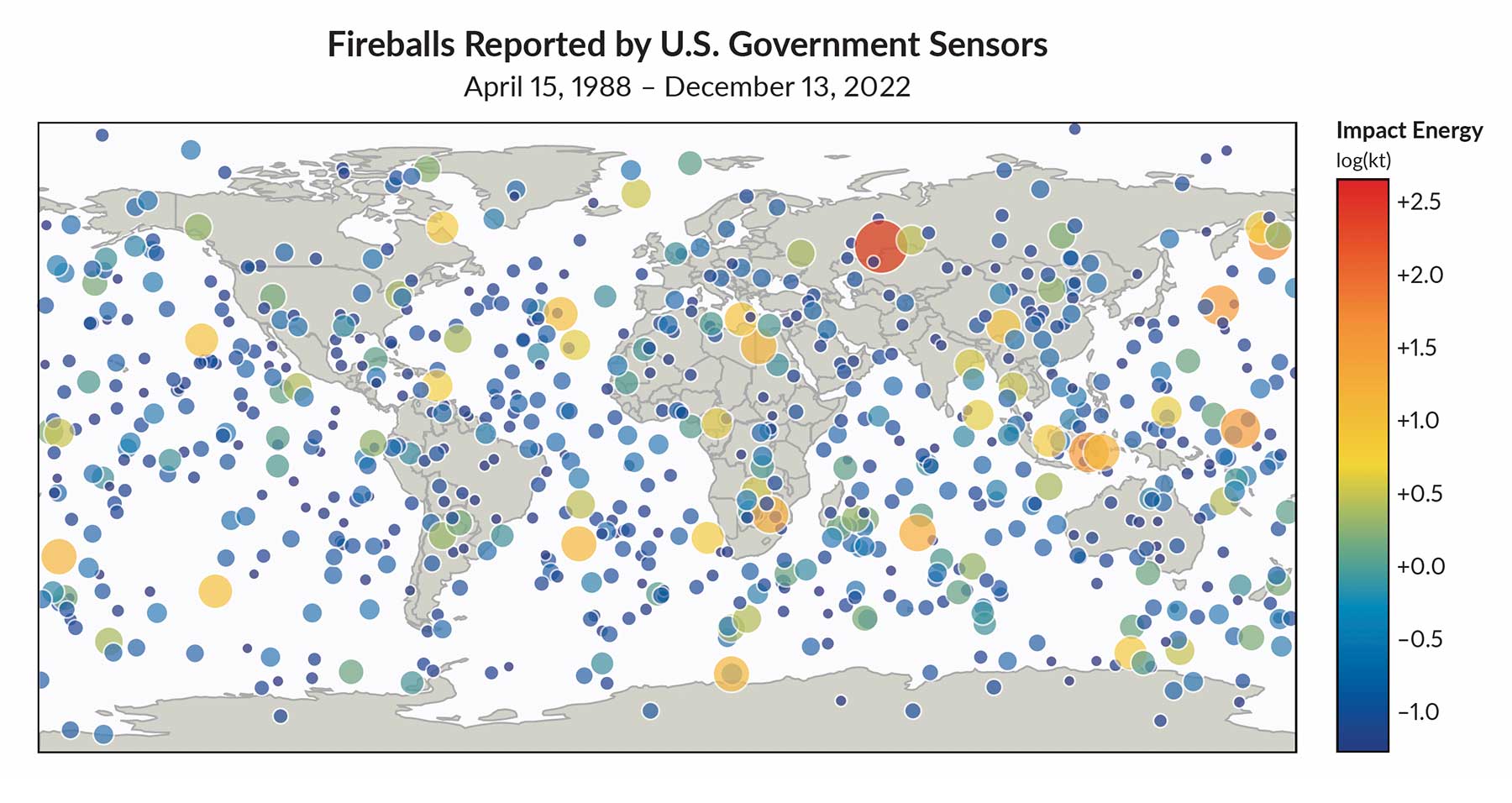The “apocalypse” in Graham Hancock’s Ancient Apocalypse is a hypothetical global catastrophe of biblical floods and continent-wide conflagrations. It was supposedly triggered by the impact of tens of thousands of fragments of a broken comet that burst in the air like bombs or exploded when they slammed into the ground. No spoiler alert is necessary. Hancock serves up a not-so-subtle animated shower of descending comets that graces the opening title sequence of every episode. The story’s narrative arc puts it on a trajectory that makes an impact hypothesis inevitable, even though Hancock avoids the word “comet” until the final episode teaser.
The supposed cataclysm’s timing coincides with the beginning of the Younger Dryas, an interval of cold climate at the end of the last ice age in much of the northern hemisphere that lasted about 1,200 years. Its year of onset is not the same everywhere, but its beginning is best discerned from an abrupt drop in temperature recorded in isotope data from Greenland ice cores in an annual layer that fell as snow about 12,920 years ago. The Younger Dryas is the latest in a series of 26 similar cold periods that took place over the last 120,000 years, called “Dansgaard-Oeschger events” (named after Willi Dansgaard and Hans Oeschger) that paleoclimatologists attribute to changes in ocean circulation caused by the influx of fresh water from melting ice sheets.1
In Episode 1, “Once There Was a Flood,” Hancock claims that there is evidence to support his notion that “the worldwide tradition of a global flood stops being just a myth and starts being a memory—an account of real events.” Puzzling over the ruins of Gunung Padang in Indonesia, for example, he concludes that such megalithic structures were built when sea levels were lower, during the last ice age:
I believe it has something to do with what happened around 12,800 years ago, when the Ice Age suddenly and quite dramatically shifted gears. Things had gradually been getting warmer for quite a long period of time. And then suddenly, two things happen at once. First, global temperatures plunge to the level that they were at the peak of the Ice Age, and they do so almost literally overnight. And secondly, there’s a sudden and inexplicable rise in sea level.
Throughout the series, Hancock incorrectly states that the Younger Dryas began 12,800 years ago, which is off by about 120 years. This is probably due to his confusion with geochronological terminology and inappropriate rounding. Ice core data reveal that the Younger Dryas began in Greenland at about 12,846 years BP, with the “Before Present” fixed at 1950 CE, or 73 years ago.2 Thus, the Younger Dryas began about 12,920 years ago, rounding to the nearest decade.
Global Flood Myths or Memories?
Hancock believes that the story of Noah in the Bible is based on fact, corroborated by other flood myths from around the world, and caused by the climate change that occurred at the onset of the Younger Dryas:
Now, normally, in an Ice Age, when you enter an episode of freezing, you do not expect to see a large amount of water dumped in the world ocean because that water has been turned into ice. What happened was a literal great flood. Between 12,800 and 11,600 years ago, the oceans of the world rose dramatically in a series of immense deluges one after another… This epoch of immense floods would have traumatized all of humanity. And indeed, there’s testimony that it did. Nearly every ancient culture preserved traditions of a great flood that swallowed up the Earth… From the Sumerians to the Babylonians, the ancient Greeks to the Chinese, all have similar versions of the same tale. The notion that all of this is just a coincidence, just invented independently by individual cultures doesn’t make sense…
Hancock makes a valid point here. Humans everywhere and at all times throughout our history tell stories of disasters they’ve experienced. Some are inspired to record them in their art or write poetry and music. The spiritual “Wasn’t That a Mighty Storm” appeared in Black churches shortly after the Great Galveston Hurricane of 1900, the deadliest natural disaster in U.S. history. “Broken Levee Blues” was written and recorded by Lonnie Johnson after the Great Mississippi Flood of 1927, the most destructive river flood in the U.S. “Five Feet High and Rising” was written and recorded by Johnny Cash about the Ohio-Mississippi Flood of 1937, another of America’s worst disasters that left a deep impression on him as a child.
These catastrophic floods all took place within one small region of the world—the south-central U.S.—within a span of 40 years (much smaller than Hancock’s century-long timing error). These folk songs represent oral history of the time and are actual accounts of real events that were traumatizing. The floods were a significant factor in the Great Northward Migration of African Americans during the first half of the 20th century, and their social impact endures.
If three epic floods had taken place within 40 years of one another about 13 millennia ago, we could not possibly know from analyzing oral histories if they were simultaneous or if the storytellers got the facts right. Even if we had physical evidence, radiocarbon dates are only accurate to within a couple hundred years, so we cannot prove that Hancock is wrong. His logic amounts to this: Since the various myths (or memories) have uncertain timing, then they could be about the same event, so they must be the same event. Further, since stories come from all around the world, then they could be about a global event, so they must be about a global event.
Of course, the ancient inhabitants of flood-prone places 12,920 years ago had no written language. They had no ability to communicate accurate information over long distances or pass it down through time. Because of their relative linguistic and technological isolation, their view of the world was inherently myopic compared to that of relatively recent times. Their horizons were very close, and they had no way of knowing whether or not the events they could observe were also taking place everywhere else simultaneously. Major flooding events, like those that took place in 1900, 1927, and 1937, would have disrupted their entire known world and affected people they encountered from beyond it. Their descendants also had temporal myopia. Verbal history is a form of copying. Since such copies are noisy (i.e., prone to variation and thereby error), they eventually become unreliable. In contrast, the 20th century had newspapers and even faster telegraph and radio, so everyone knew that these were not global events. Even today, we can go to the internet to read first-hand accounts of long-dead individuals who experienced these events as adults.
Graham Hancock’s Global Apocalyptic Flood
In addition to timing, Hancock’s facts about sea level rise during the late Pleistocene are also wrong. There is no evidence that the world’s oceans rose dramatically in a series of deluges during the Younger Dryas. Hancock’s claim contradicts the sea level data collected around the world (Figure 1). For example, corals in Barbados recorded rates decreasing from 20 mm/year at 13,900 years BP (before 1950) to 4 mm/year 11,550 years BP.3

Figure 1. Sea level rise for the last 24,000 years, based on published compilations of data. Credit: Robert A. Rohde: http://bit.ly/3WXq2Va. Click image to enlarge.
In 1937, Johnny Cash’s family was warned that they had to “head for the hills” as his papa watched the water come up five feet (1.5 meters) and keep on rising, before he abandoned their house that day.4 Even at 20 mm/year, that would take 75 years, much longer than the average lifetime of a coastal inhabitant 12,800 years ago. The storm surge associated with the 1900 Galveston flood was up to 3.7 meters, corresponding to 185 years of sea level rise during Hancock’s proposed flood catastrophe.
In round numbers, the current rate of sea level rise is 4 mm/year (and rising), about the same as at the end of the Younger Dryas, a rate that many global warming deniers dismiss as too low to be concerned about or even to measure. It’s this day-to-day imperceptible sea-level rise that Hancock thinks concerned the ancients most, as they seem to have ignored the catastrophic floods that take place multiple times every generation in many parts of the world.
In subsequent episodes, Hancock repeats the false claim that there was a major and unique sea level rise event 12,800 years ago as he attempts to tie it in with flood mythology.
Episode 2, “Stranger in a Time of Chaos”:
A period of great cataclysms and floods that had as big an impact here as it did nearly everywhere else in the world…sometime at the end of the last Ice Age, around 12,800 years ago. Could the story of Quetzalcoatl’s arrival date back as far as that?
Episode 3, “Ghosts of a Drowned World”:
So we have a date for the destruction of Atlantis, 9600 BC. That’s exactly the same time as an episode of global cataclysm and catastrophic sea level rise that occurred at the end of the Ice Age. Coincidence? Maybe.
Episode 5, “Legacy of the Sages”:
We’ve been referring to this as the Ancient Apocalypse, but scientists call it the Younger Dryas. It began 12,800 years ago with a cataclysm, and it ended 11,600 years ago, the exact date of the construction of Göbekli Tepe. The world suffered through some kind of tremendous geological upheaval, including immense floods, followed by more than 1,000 years of freezing temperatures. Life on Earth fundamentally changed. The saber-toothed tigers and mammoths went extinct. But humanity survived. And around 11,600 years ago, the freeze ended with another final immense flood that raised sea levels around the world. It was then, only after the Earth was calm again, that the work on Göbekli Tepe began. And I believe the timing was no coincidence.
Unfortunately for Hancock the rate of sea level rise during the Younger Dryas was lower than it was just before the Younger Dryas. During more than ten thousand years of relentless but probably unnoticed sea level rise, local and regional catastrophes like the 1900 Galveston hurricane and the 1927 Mississippi flood undoubtedly happened somewhere on Earth every year, wiping out settlements, destroying livelihoods, killing people, and displacing survivors. Stories about such events are going to be passed to future generations as oral histories or other forms of non-written communication and recorded petroglyphs, monuments, and chants.
The Younger Dryas Impact Hypothesis
Hancock begins building the case for a comet impact in the last several episodes. In Episode 6, “America’s Lost Civilization,” he associates Ohio’s Serpent Mound Valley with the end of the last ice age when “something huge was happening all over the planet” (again getting the timing wrong):
Something apocalyptic called the Younger Dryas. It was a period of radical climate change and rising sea levels. Humanity survived, but barely. I find it intriguing, by means of its alignment to the summer solstice sunset, that Serpent Mound serves as a signpost, a date stamp, drawing our attention to the skies of 12,800 years ago, a time when we know there was a global cataclysm big enough to have destroyed an advanced civilization.
Eventually, Hancock drops his first hint about the Younger Dryas Impact Hypothesis (YDIH):
Perhaps the stars, or something resembling stars, did fall to Earth. Perhaps there was great flooding afterwards, part of those earthshaking cataclysms of the Younger Dryas. If the original version of Serpent Mound was designed sometime around the end of the last Ice Age, as I believe, then perhaps it was intended to carry a message to the future, a warning even, as to what caused that apocalyptic series of events around 12,800 years ago, a warning to look to the heavens for stars falling from the sky.
In Episode 7, “A Fatal Winter,” Hancock visits other archaeological sites around the world that point him in one direction— the YDIH in which he introduces his grand finale:
For a long time, it remained a mystery as to what triggered the floods, fires and plunging temperatures of the Younger Dryas, but new geological evidence has suggested a terrible possibility. Evidence still visible today in the scarred landscape of prehistoric America, where I’m headed next. I’m quite persuaded that the origin of serpent symbolism has to do precisely with those serpents in the sky that we call comets.
Uniformitarianism vs Catastrophism
As a subject matter expert in impact physics and planetary defense, it is my professional opinion that Graham Hancock misrepresents science in claiming that there is a strong “what’s called ‘uniformitarian trend’” in geology. Ironically, he makes that assertion while discussing the Channeled Scablands, for which the widely accepted geological explanation is a series of catastrophic floods from ice dam collapses that released water from the enormous prehistoric Lake Missoula. Regarding this event, at least, geologists are catastrophists. Nevertheless, Hancock goes on to say that “modern geologists” don’t like cataclysms very much. Not so. It waIt was a modern geoscientist named Gene Shoemaker who proved that Meteor Crater in Arizona and Ries Crater in Bavaria were created by asteroid impacts. And another named Walter Alvarez was one of the leaders of the team that discovered the impact event that wiped out the dinosaurs. Modern geologists embrace cataclysms fully…when there is evidence for them.
Unfortunately, in his Netflix series, Hancock doesn’t interview any scientists or subject matter experts about impact physics or geology. Instead, he asks amateur geologist and author Randall Carlson to weigh in on his unorthodox speculations that the professionals don’t know what they are talking about, haven’t properly identified the source of floodwaters, and that the water actually came from the Arctic ice cap. Carlson also thinks that the floods are not as old as geological dating demonstrates, and are really a single event that happened at the onset of the Younger Dryas.
It’s Comets!
Hancock did interview Allen West, the mastermind of the YDIH and leader of the so-called Comet Research Group. West’s unconventional career path toward avocational science parallels that of Hancock (a journalist who became interested in archaeology) and Carlson (an author and podcaster interested in geology). Like Hancock and Carlson, West (a consultant and self-taught geologist) began his foray into unorthodox science by writing a book for a publisher that specializes in new age beliefs (Inner Traditions). His 2006 book, The Cycle of Cosmic Catastrophes, introduced the YDIH. It was updated the following year in the first paper in the peer-reviewed Proceedings of the National Academy of Sciences,5 by a group of authors that incorporated themselves as the Comet Research Group (CRG) in 2016.
Plagued by self contradictions, logical fallacies, basic misunderstandings, misidentified impact evidence, abandoned claims, irreproducible results, questionable protocols, lack of disclosure, secretiveness, failed predictions, contaminated samples, pseudoscientific arguments, physically impossible mechanisms, and misrepresentations, the YDIH has never been accepted by experts in any related field.6 Authors of these skeptical papers include Vance Haynes7, 8, 9, 10 (who discovered and characterized the black mat, central to YDIH claims) and Michail Petaev11, 12, 13 (lead author of the paper describing a platinum anomaly in Greenland, falsely cited by proponents as evidence for the YDIH). These problems are summarized in many peer-reviewed and popular articles, most recently in an exhaustively researched review article, now in review.14
The skepticism has increased following instances of questionable conduct by the Comet Research Group leaders that included a pattern of personal attacks on skeptics15, 16 inappropriate data manipulation17, 18, 19 and a conviction for a crime of dishonesty involving misrepresentation of scientific credentials.20, 21
Speaking only for myself, the persistent lack of transparency by the CRG suggests that information contradicting their hypothesis is being withheld, which raises a serious red flag. Several of the supposed “impact markers” cited in their original paper seem to have failed to pan out. For example, no data was ever provided to support the claim of “fullerenes with extraterrestrial helium.” (Fullerenes are a form of carbon having a large spheroidal molecule consisting of a hollow cage of atoms, of which buckminsterfullerene was the first known example). The three coauthors responsible for that work have never published anything about it again and are either unreachable by email or unresponsive to questions. Most proponents have stopped citing extraterrestrial fullerenes as evidence, but the claim has never been officially withdrawn. One must ask, “Why?”
Another line of evidence that seems to have fallen out of favor, but has not been formally withdrawn, is the putative discovery of hexagonal nanodiamonds [diamond particles with dimensions of only a few nanometers] at the Younger Dryas Boundary in Greenland in 2008 for an episode of the true science series NOVA that was removed from streaming after producers discovered irregularities in the story they were told. An expedition by other CRG members back to Greenland in 2009 failed to confirm the 2008 discovery, but this negative result was never published. Why?
None of the other supposed impact markers listed in the original 2007 paper are unique to impact. The graphs of abundance data for those indicators exhibit puzzling anomalies that suggest improper plotting. After 15 years, however, the authors of that paper have never made their raw data available. Again, one must ask “Why?”
In an effort to give the YDIH proponents an opportunity to publicly answer these questions and make their data available to everyone, I recently created several PubPeer pages. I would encourage other skeptics to use PubPeer to ask their own questions and request release of the raw data that is required to make an informed judgment about the hypothesis.22
These ongoing issues aside, West’s and Hancock’s claims about the YDIH, such as West’s assertion that the Earth was hit by tens of thousands of comet fragments, and Hancock’s estimate that there are probably 200 objects bigger than a kilometer in diameter in the Taurid meteor stream, still go far beyond what anyone has been able to get through peer review.
West’s extraordinary claim lacks evidence. Several scientists, including myself, suggested a test for this idea several years ago. If there were a Tauridresonant swarm containing large objects in sufficient numbers to affect the impact risk, it would have been observable in the summer of 2019. We urged an observational campaign that had the potential to confirm YDIH speculations about its existence.23, 24 Lack of confirming observations suggest that this is yet another failed prediction of the YDIH.
Consideration of Relevant Information Is Not a Fallacy
Science is a field that is built on trust, and researchers must always consider the reliability of the sources of information on which they base their professional opinions. It is common for scientists to reject data that is produced by a scientific instrument that they know to be untrustworthy, and the same is true when assessing information from any source they judge to be unreliable.
West’s fraud conviction and other misdeeds put YDIH skeptics into a Catch-22 situation. When we learned that West had pretended to be a trained geophysicist to bilk California taxpayers, many of us stopped believing any data for which he was solely responsible regarding the impact hypothesis—which is most of it. Our discovery of modern-aged carbon spherules in supposed Younger Dryas Boundary (YDB)-aged samples prepared by West (with the spherules being the source of supposed YDB impact diamonds) made us all the more suspicious. The “discovery” of hexagonal diamonds for a TV show, in samples prepared solely by West a couple months after they were collected in 2008, could not be reproduced in the subsequent 14 years following another expedition for that purpose; this added to our mistrust. West’s ongoing refusal to share samples—or even reveal his raw data—gives the appearance of his having something to hide. Of course, we cannot prove misconduct in cases other than the image manipulation or the fraud in California, both of which he admitted—one under penalty of perjury— when he applied for and was granted an expungement.
Thus, in addition to the problems with West’s data discussed above, I believe scientists have a perfectly valid reason to be extra skeptical of his claims about the YDIH. This is not an argumentum ad hominem fallacy. Assessing the reliability, competence, honesty, and professionalism of a practitioner of science in their relevant field is no different than examining the bona fides of an accountant, lawyer, housekeeper, or child-care provider before hiring them. This is why job applications often require letters of recommendation and background checks. The ad hominem fallacy only applies to criticism of someone because of personal characteristics that are irrelevant to the claim they are making. To be clear, I am not making any accusations of fraud or misconduct other than for the cases that have already been admitted. Since raw data have not been made available, and samples have been withheld, I cannot make a judgment one way or another about the veracity of that evidence.
In the final episode of Ancient Apocalypse, West told Hancock that, “Scientists unfortunately are taught to be cynical about things.” No, they are not. Rather, they are taught to be skeptical, that is, curious, logical, rigorous, open, and honest. These are mindsets that both West and Hancock would do well to put in practice.
It’s Not Comets!
There are other fatal scientific flaws with the YDIH, some of which require detailed technical explanations that have already been published. There is also at least one fatal logical flaw that is easy to explain to non-specialists. It employs exactly the same circular logic that Hancock applies when he claims that ubiquitous flood myths refer to a single global event, as opposed to many different undated and unspecified local and regional floods that were catastrophic to the observers but went unnoticed to everyone else in the world.
Near Earth Objects (NEOs) are asteroids and comets that visit the vicinity of Earth’s orbit. Astronomical surveys, populations of craters on the moon, and observations of meteors entering the Earth’s atmosphere have allowed us to quantify the number of objects of a given size that can be expected to collide with the Earth over a given period of time. Meteorologists and insurance actuaries talk about “hundred-year floods,” the sizes of which are location-dependent. By analogy, planetary defenders can talk about “hundred-year impacts” for the entire planet.
For example, we estimate that an object the size of the one that exploded over Siberia, known as the Tunguska event, on average and over the long run, happens somewhere once every 500 years. We estimate that the asteroid that exploded over Chelyabinsk, Russia in 2013, injuring 1500 people, in terms of mass and energy was about a tenth as big as the Tunguska asteroid. There are about ten times as many Chelyabinsk-sized NEOs as there are Tunguska objects, so they happen 10 times as frequently—with a long-term average occurrence somewhere on the planet of every 50 years.25 Figure 2 shows the history of incoming asteroids that burn up as fireballs, as recorded by U.S. sensors around the world.

Figure 2. Reported bolide events with geographic location data from U.S. government sensors, released by NASA Jet Propulsion Laboratory’s Center for Near Earth Object Studies. Credit: Alan B. Chamberlin (JPL/Caltech). Source: https://cneos.jpl.nasa.gov/fireballs/. Click image to enlarge.
When one of these objects explodes in the atmosphere its mass does not magically disappear. Most of it vaporizes and then re-condenses in the form of spherules that fall out nearby. If it’s rich in platinum-group elements, the condensed vapor contributes to their abundance at the surface. In cases where diamond-bearing meteorites fall, the nanodiamonds are the last component to weather away because of their hardness and chemical inertness. Every location on Earth is likely to have peak abundances in meteoritic material associated with the long-term flux of local or regional airburst events in its sedimentary column.
The circular logic of the Comet Research Group is similar to Hancock’s circular flood logic:
Hancock Flood Logic
- Hypothesis: There was a global flood.
- Fact: There are flood stories from every culture.
- Fact: There is uncertainty in the time and extent of the floods in the stories.
- Inference: If the Hypothesis is true, then the stories are all about the same flood.
- Conclusion: If the stories are all about the same flood at the same time, then the Hypothesis is true.
However, the actual CRG impact logic is even worse, because not all spherules, platinum-group elements, or nanodiamonds are impact markers. Some can have terrestrial origins, and can even be anthropogenic or introduced contaminants. To wit:
CRG Impact Logic
- Hypothesis: There was a global comet catastrophe.
- Fact: There are indicators that might be impact markers in sediments of roughly the right age.
- Fact: There is uncertainty in the age and extent of the indicators.
- Inference: If the Hypothesis is true, then the indicators are impact markers that are from the same impact at the same time.
- Conclusion: If the indicators are impact markers that are from the same impact at the same time, then the Hypothesis is true.
CRG impact logic is illustrated by Figure 3. Only a fraction of the dated samples is within a standard deviation of the Younger Dryas boundary (lower edge of the shaded band). None of these locations have been shown to lack concentrations of indicators at other stratigraphic depths. The indicators are presumed to be impact markers and therefore provide a valid cosmic stratigraphic index of the YD onset. Most radiocarbon dates must therefore be rejected. This confirmation bias and circular logic exactly parallels Graham Hancock’s reasoning that undated or poorly dated oral histories are evidence for a global flood.

Figure 3. 14C dates of samples purported to be from the Younger Dryas boundary (error bars indicate ± 1 standard deviation). The shaded band is the Younger Dryas. Source: Holliday et al. (2014).26 Click image to enlarge.
Conclusion
In my opinion, Graham Hancock’s Ancient Apocalypse has many of the attributes of pseudoscience: rejection of the scientific method, extraordinary claims without extraordinary (or even ordinary) evidence, dismissal of contrary evidence, contempt for recognized subjectmatter experts, unfalsifiable claims, confirmation bias, and lack of peer review. Nevertheless, some skeptics might conclude that the one scientifically viable element of Ancient Apocalypse is the hypothesis that a swarm of comet fragments triggered a global catastrophe at just the right time by colliding with the Earth.

This article appeared in Skeptic magazine 28.1
Buy print edition
Buy digital edition
Subscribe to print edition
Subscribe to digital edition
Download our app
As well, and given the fact that peer review is fallible, it is my professional opinion that the YDIH should also be viewed by skeptics with suspicion. Virtually all experts, working independently in the relevant fields, who have stated their opinions about the YDIH, have expressed skepticism. The negative scientific consensus that emerged very quickly after the first peer-reviewed publication introduced the YDIH 15 years ago has not changed.
Graham Hancock’s series has not swayed scientists from maintaining their skeptical opinion (indeed, it has amplified with increased data and analyses) despite the popular interest it has garnered. If YDIH researchers want to convince scientists that their hypothesis is scientifically viable, they must become more transparent about their evidence by making their raw data available and by admitting and publishing their failures. In short, they must become scientists, not storytellers.
In memory of Ken Frazier, my friend and skeptical mentor. He was dedicated to the promotion of science and reason as the longtime editor of the Skeptical Inquirer, and to the love of natural beauty, wildlife, mountain vistas, sunsets, night skies, and his family and friends. In the farewell column he penned when he knew he only had a few weeks left, he expressed confidence that new generations will continue to carry the torch of the scientific skepticism and wonder that were so important to him. Let’s honor his memory by ensuring that his faith in us was well placed. ![]()
About the Author
Mark Boslough received his PhD (Caltech, 1983) in applied physics, with studies in geophysics. He joined Sandia National Laboratories, where he was an experimental and computational physicist. He departed Sandia in 2017 and joined Los Alamos National Laboratory. His research is focused on computational modeling of airbursts, their physical effects, and their contribution to the NEO risk. He participated in documentary field expeditions to airburst sites, including the Libyan Desert of Egypt, Tunguska, and Chelyabinsk. He served on the asteroid mitigation panel for the National Research Council and coauthored the report “Defending Planet Earth” delivered to Congress.
References
- See, for example: Schulz, M. (2002). On the 1470-year pacing of Dansgaard-Oeschger warm events. Paleoceanography 17(2) 41–49.
- https://bit.ly/3G9FRld
- https://bit.ly/3IhTr8E
- https://bit.ly/3I5xfyr
- https://bit.ly/3X0bDrO
- For this citation I have compiled over 50 references to peer-reviewed scientific papers, which may be found here: http://bit.ly/3wkqJNg
- https://bit.ly/3WWtwrl
- https://bit.ly/3jEyHOd
- https://bit.ly/3Gzg9Io
- https://bit.ly/3WGgu1g
- https://bit.ly/3VNiyDK
- https://bit.ly/3GbuM2V
- Holliday, V.T., Daulton, T.L., Bartlein, P.J., Boslough, M., Breslawski, R.B., Fisher, A.E., Jorgeson, I.A., Scott, A.C., Koeberl.C., Marlon, J., Severinghaus, J., Petaev, M.I., Claeys., P., (2023). The Younger Dryas Impact Hypothesis: A Cosmic Catastrophe Revisited (in review).
- Holliday, V.T., et al. (2023). op cit.
- Howard, G. in the “Cosmic Tusk” blog. Howard is CRG director, cofounder, and YDIH coauthor. He frequently posts personal attacks and engages in smear campaigns against critics of the CRG, YDIH, and Graham Hancock. In addition to me, his targets have included, Elizabeth Bik, Alexandra Witze, Christian Koeberl, John Hoopes, Marc Defant, Vance Holliday, Todd Surovell, David Meltzer, Alan Harris, Faye Flam, Nicholas Pinter, Tyrone Dalton, Jaqueline Gill, Phil Plait, Andrew Scott, Dick Kerr, Rex Dalton, and David Morrison. He often refers to his targets by nicknames he has created. Mine is “The Bos” and he created an entire category dedicated to me, called “The Bos Files” which was archived shortly after the CRG was incorporated. https://bit.ly/3WStpge
- Bik, E. (2021). Blast in the past: Image concerns in paper about comet that might have destroyed Tall el-Hammam. Science Integrity Digest.
- https://bit.ly/3WWDSYj
- https://go.nature.com/3iaDpmv
- Allen West has agreed to publish another correction to replace another inappropriately modified image and to remove false statements: https://bit.ly/3Ghw2BY
- Dalton, R. (2011). Comet theory comes crashing to Earth. Pacific Standard (May 14).
- Allen West, formally Allen Whitt, Declaration of Defendant. Aug. 11, 2010, Case No: FWI—012305, Superior Court of the State of California for the County of San Bernardino. “On March 4, 2002, I was convicted in the Superior Court of the County of San Bernardino of the charge of violation of Business and Professional Code section 17500.”
- Here is a list of links to active PubPeer pages about articles supporting the YDIH and other CRG research, but which contain uncorrected false statements and/ or unanswered questions about data: https://bit.ly/3i0JGRS, https://bit.ly/3G2mfzq, https://bit.ly/3vt85m9, https://bit.ly/3WWEbCr, https://bit.ly/3i58fwX, https://bit.ly/3CiKEQh
- https://wapo.st/3Qaotl5
- https://bit.ly/3GB0uIE
- Boslough, M., Brown, P. and Harris, A., 2015, March. Updated Population and Risk Assessment for Airbursts From Near-Earth Objects (NEOs). In 2015 IEEE aerospace conference (pp. 1–12). IEEE.
- https://bit.ly/3GH4J59
This article was published on April 21, 2023.














